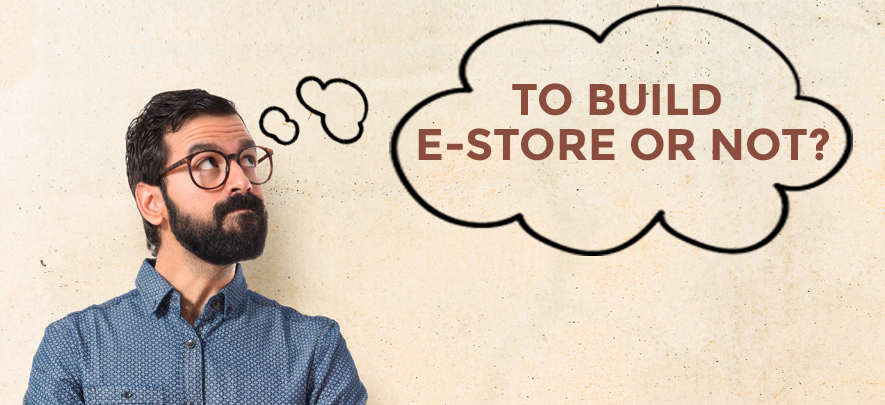Wondering if you should build your own ecommerce website or not?

Ecommerce
285 week ago — 8 min read
SMEs have been successfully selling their products via marketplaces for a long time now. Marketplace is an e-commerce website where you can list your products which is then sold by the marketplace operator (e.g. Amazon and eBay). Marketplaces are forerunners in making SMEs experience ecommerce and for SMEs who are retailing online, they are an indispensable and one of the largest revenue streams.
But in an evolving digital landscape, most SMEs at some stage of business growth are confronted with a fundamental question: Should I create my own e-commerce store or not?
The answer is an emphatic ‘yes’. At a time when majority of your customers are digitally savvy, an e-commerce website is a must to remain relevant and offer your customers a customised shopping experience. Find out the five major benefits of having your own online store.
1. You can grow your own customer base
The size of your customer base defines the strength of your business and its value. To maintain your foothold in a competitive market space, creating your e-commerce website is essential to expand your customer reach. This will not only allow you to engage with more customers but will also pave the path for a new revenue stream round the clock. All this in turn will greatly reduce your dependence on marketplaces and your brick and mortar stores. So, while you can continue retailing on marketplaces, you can attract more customers to your e-store at the same time and retain your customers easily.
Furthermore, your e-store will allow you to roll-out new products quickly by easily reaching out to trusted and loyal customers. Thus, significantly reducing new product roll-out marketing spend.
A problem faced by most brands while dealing with millennials is that they don't demonstrate brand loyalty like their predecessors, thus making it difficult for brands to predict buying patterns and successfully gain repeat orders. Being a social media driven generation, millennials engage with multiple brands simultaneously. So, if you want to win them over, you need to build a strong e-store. You can do so even with your stores on various marketplaces, but it will be a half-baked approach where you are competing with other sellers as well. Wherein at one end you are putting in monumental effort to engage and nurture customers and on the other end you are requiring them to transact with you through an external entity. As technology takes over, businesses without a unique digital presence will find it difficult to sustain in the future.
2. Deliver omnichannel customer experience
Modern customers unlike traditional customers, like to engage and transact with a brand across channels and mediums. Thus, a customer who has bought a product from one of the brand’s brick and mortar store might want to buy it online from the brand’s e-commerce website or someone who has bought the brand’s product from a marketplace might want to buy directly from the brand’s e-commerce website. With an e-store, your brand can easily render a seamless omnichannel experience to all its customers.
3. Save on commission, invest in digital marketing
A big apprehension that prevents SMEs from building their own e-commerce website is misconceptions about digital marketing and doubts about their ability to bear the cost of digitally marketing their products.
One clear advantage marketplaces have is that an SME does not have to invest in marketing their product, all they have to do is to upload their catalogue on a marketplace. However, this does not hold true anymore. The number of sellers on marketplaces is increasing by the day and with numerous sellers showcasing similar products, probability of scoring an order is decreasing rapidly. A smarter alternative is to build an e-commerce website and invest the money you would otherwise pay to marketplaces as commission and advertising fee, in marketing your own e-commerce website. Of course, in this case you have to invest upfront, however the return is significantly greater as it will give you customers for a lifetime.
4. Leverage offline to build online and vice versa
Brands and businesses which have a brick and mortar presence have a good brand equity and customer base and they can easily leverage this to gain momentum on their e-commerce website.
Actions as simple as sharing a discount code with everyone who walks into the brick and mortar store will start getting traffic to your e-commerce website. Further, it will also give you an opportunity to engage and convert a customer who did not purchase anything from the store.
Further, for most retailers it is not possible to showcase all the products in a brick and mortar store, however if they have an e-commerce website, they can simply equip their sales staff with a mobile device to show customers what else you have, and the order can be placed at the store thereby minimizing the probability of losing a sale.
Here are some scenarios to explain this further.
Scenario 1:
Ms. X walks in a store, she gets greeted by the sales staff and reviews the store’s catalogue, but does not find what she is looking for, so store staff asks if she would like to view other products which are available on their e-store. Ms. X agrees. Store staff show her the online catalogue on a tablet, she likes a product, staff informs Miss X that if she places an order from the store, she will get additional 10% discount. Ms. X likes the offer and places the order.
Thus, the brand gets an order and a customer which they would have lost otherwise resulting from their sole dependence on conventional physical stores.
Scenario 2:
Ms. X walks into a store, she is greeted by store staff and reviews the store’s catalogue, but does not find anything of interest, so store staff asks if she would like to view other products on the e-store. Ms. X refuses as she was in a hurry, so store staff hand her a 10% discount coupon which she can later use to buy from the e-store.
5. It's an asset not a liability
Developing and maintaining an e-commerce website requires sizable and consistent involvement and investment, making it look like a liability, whereas in reality it is an asset.
Your e-commerce website can become your most important asset as it allows you not only to aggregate and retain but also engage with your customers.
Further, many SMEs have a false notion that an e-commerce website is a magic tool and just developing it will give them new business. A website has to be promoted and presented to the right audience. SMEs should treat their e-commerce website as setting up a new brick and mortar store, although investment in setting up an e-commerce website is significantly less as compared to a physical store, however SMEs should utilize the cost difference to market their e-commerce website.
Example -
Brand X has to make the following investments in setting up a physical store:
One Time
Store fit outs - USD 14,000
Recurring
Monthly rent - USD 1,400
Staff salary - USD 700
Brands investment in development of its e-commerce website will be:
One Time
Store setup - 0 (using Linker.store)
Recurring
Digital marketing budget - USD 1,400
Agency fee - USD 700
You can see from the above example that a brand can easily gain equal or larger volume of new business from its e-commerce website with proper marketing. And if you are worrying about hiring a good web developer to create an e-store for you and the expenses that goes in marketing, Linker.store is the solution to your problem. Not only does it allow you to register and set up your e-store free of cost, but it can be easily customised as per your needs.
So what are you waiting for, its time to create your very own e-commerce store.
Posted by
GlobalLinker StaffWe are a team of experienced industry professionals committed to sharing our knowledge and skills with small & medium enterprises.
Network with SMEs mentioned in this article
View GlobalLinker 's profile
SME Inspirations
Other articles written by GlobalLinker Staff
Declutter Your Business the Marie Kondo Way
12 week ago
Most read this week

















Comments (3)
Please login or Register to join the discussion